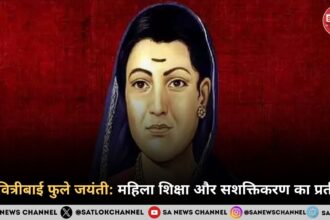If elegance, grace, and humanity have a face, then it would surely be Audrey Hepburn. Surviving the hardships of the war at a young age, she overcame adversity with strength to become one of the most enduring figures in film and fashion. Audrey Hepburn was not only known for her extravagance but was defined by her resilience, humility, and benevolence. Her story is not only that of a movie star but a long tale of a kind woman who rose from wartime struggles to global fame. The story of a woman who dedicated herself to helping the most vulnerable children around the world.
- Audrey Hepburn’s Early Life and Childhood
- Rise to Stardom: Audrey Hepburn’s Acting Career
- Iconic Movies That Made Audrey Hepburn a Legend
- Audrey Hepburn as a Fashion and Style Icon
- Humanitarian Work: Audrey Hepburn’s Legacy Beyond Cinema
- Awards and Accomplishments of Audrey Hepburn
- Personal Life and Family of Audrey Hepburn
- Later Years and The Enduring Legacy of Audrey Hepburn
- Saint Rampal Ji Maharaj: Working For the Cause of Poor
This biography provides deep insight into Audrey Hepburn’s childhood, her wartime struggles, her rise to fame, her most loved movies, and her remarkable humanitarian journey.
Audrey Hepburn’s Early Life and Childhood
Audrey Kathleen Ruston, known to the world as Audrey Hepburn, was born to Joseph Hepburn-Ruston and Ella van Heemstra on May 4, 1929, in Brussels, Belgium. Born in a privileged family, Audrey Hepburn faced displacement, unpredictability, and personal upheaval during her early childhood. Her father, Joseph Hepburn-Ruston, was a businessman who worked for the trading company and her mother, Ella van Heemstra was a Dutch noblewoman.
Audrey’s father left the family when she was just six, this painful separation left her deep emotional scars which stayed with her until lifetime. After her father left the family, Audrey’s mother took the responsibility of raising her through times of both privilege and hardship, instilling in her the qualities of discipline, culture, and resilience.
World War II affected Audrey Hepburn’s life emotionally, physically, and mentally. Audrey began her schooling at Miss Rigden’s School, Elham, Kent, England, from 1936 to 1939. Soon after the war started, Audrey moved to the Netherlands with her family and continued her education at the Arnhem Conservatory from 1939 to 1945, studying ballet. Audrey had to face the ill effects of the war; she was stuck in the Nazi-occupied Netherlands, where food shortages and violence became everyday realities.
She suffered from malnutrition and anemia. In addition to her worsened health, Audrey also witnessed the horrors inflicted on her community by the Nazis. This suppressed Audrey’s dreams of childhood joy in exchange for survival. Yet in these difficult times, Audrey found retreat in ballet. She took ballet lessons under Winja Marova, believing that it might save her both emotionally and professionally. The hardships that she faced during this era later manifested in the quiet vulnerability of her screen presence and explained her unwavering compassion for those in need.
Rise to Stardom: Audrey Hepburn’s Acting Career
Due to her weakened health, Audrey was unable to attain the status of prima ballerina. Accepting her limitations, Audrey focused more on acting. She began with small roles in European films such as Dutch in Seven Lessons (1948) and also worked as a chorus girl in London’s West End theater. It was Audrey’s tender features, her big expressive eyes, and her natural elegance that made her stand out on stage and screen in all her appearances.
Also Read: Biography of Coco Chanel: Orphanage Girl To Revolutionary Fashion Designer
Audrey’s major rise to fame occurred by chance. While filming in Monte Carlo, she caught the attention of the famous French novelist Colette, who offered Audrey the lead role in her novel, Gigi (1951). Audrey’s performance in Gigi attracted recognition from critics and launched her as a rising and luminous talent. Soon Audrey was offered Roman Holiday (1953) opposite Gregory Peck. The film was a blockbuster.
Audrey’s role as a young princess aspiring for freedom was authentic, heartwarming, and utterly relatable. For her performance, she won the Academy Award for Best Actress, instantly establishing herself as one of Hollywood’s exceptional talents.
Iconic Movies That Made Audrey Hepburn a Legend
Audrey Hepburn’s career heightened with a series of unforgettable cinematic gems, each portraying Audrey’s versatility and luminous screen presence. Here are some of Audrey Hepburn’s blockbuster classical cinematic films that made her a Timeless Legend.
- Sabrina (1954), a romantic comedy with Humphrey Bogart and William Holden.
- Funny Face (1957), a musical in which she sang her own parts.
- The Nun’s Story (1959), a drama about a nun struggling with her vows.
- Breakfast at Tiffany’s (1961), portraying the unforgettable Holly Golightly.
- Charade (1963), a romantic mystery opposite Cary Grant.
- My Fair Lady (1964), as the iconic Eliza Doolittle.
- Wait Until Dark (1967), a thriller where she played a blind woman under threat.
All these films—from romantic comedy to intense thrillers contributed to her legend. Her movies till today are the most watched and loved pieces of classical cinema.
Audrey Hepburn as a Fashion and Style Icon
Audrey Hepburn was not only a bright cinema star, but was a global fashion and style icon—a status shaped significantly through her lifelong collaboration with famous French fashion designer Hubert de Givenchy. With Hubert de Givenchy, she also crafted some of fashion’s most unforgettable times, from the black dress in Breakfast at Tiffany’s to the classy gowns in Sabrina. Audrey promoted the little black dress, ballet flats, cropped trousers, and the pixie haircut—basic, classical styles that are fashion inspiration to millions to this day.
Unlike many in Hollywood, who embraced flamboyance, Audrey was different. She wore authenticity and her wardrobe reflected that. She was eternally elegant without pretension—whether it was custom gowns, casual Capri pants, or classic trench coats. That is why “Audrey Hepburn fashion” will always remain trending; generations after generations are still inspired by her simple, graceful, and sophisticated style.
Humanitarian Work: Audrey Hepburn’s Legacy Beyond Cinema
Audrey Hepburn’s extraordinary humanitarian contributions are a testimony to her selfless compassion toward children. Having experienced hunger and fear, the two harsh realities of life during World War II, she felt the pain and suffering of the children in crises. In the late 1980s, Audrey Hepburn became a UNICEF Goodwill Ambassador and spent much of her later life traveling to the world’s most poverty-stricken regions.
Audrey approached every mission with empathy, whether it was visiting famine victims in Ethiopia or supporting vaccination campaigns in South America and Asia. Unlike celebrities who simply lent their names for the sake of seeking attention, she devoted herself to the cause of these children. At once, she was holding malnourished children, engaging with mothers, and speaking passionately to world leaders.
She once said, “I feel so strongly that it’s wonderful to be able to give back.” Her sincerity was undeniable; she wasn’t acting but reliving memories of her own childhood fears of hunger and loss. It was due to her impactful humanitarian legacy that, in 1992, President George H. W. Bush awarded her the Presidential Medal of Freedom, in recognition of her selfless devotion to the world’s children.
Awards and Accomplishments of Audrey Hepburn
Audrey Hepburn had an exceptional career that was recognized by numerous distinguished honors and awards. Each of these recognitions reflects her extraordinary abilities as an actor in film, stage, as well as her dedication to humanitarian service.
- Academy Award for Best Actress for Roman Holiday (1954)
- Five total nominations for the Oscars for Sabrina, The Nun’s Story, Breakfast at Tiffany’s, and Wait Until Dark
- Jean Hersholt Humanitarian Award (awarded posthumously in 1993)
- Three BAFTAs for Best British Actress out of five nominations
- BAFTA Lifetime Achievement Award (1992)
- Two Golden Globe Awards out of ten nominations
- Cecil B. DeMille Award (Golden Globes) in 1990
- Tony Award for Best Performance by a Leading Actress in a Play for Ondine (1954)
- Special Tony Award (1968)
- Primetime Emmy Award awarded posthumously for Gardens of the World with Audrey Hepburn
- Grammy Award for spoken-word recording Audrey Hepburn’s Enchanted Tales
- Acknowledged as one of the few entertainers to win an Academy, Emmy, Grammy, and Tony Award (EGOT)
- Ranked 3rd on the American Film Institute’s list of the top 100 female stars of Classic Hollywood cinema
- Featured on US postage stamps
- Has a star on the Hollywood Walk of Fame
But right beside that, her greatest accomplishment may have been in being able to inspire millions of people through her acting and kindness.
Personal Life and Family of Audrey Hepburn
Audrey Hepburn was famous worldwide, but she reserved a good amount of space for her simplicity, privacy, and family. Audrey Hepburn married twice. Firstly, she married Mel Ferrer on September 25, 1954, in a private civil ceremony at the Bürgenstock Chapel in Ennetbürgen, Switzerland. With Mel Ferrer, she had her son Sean Hepburn Ferrer, and later she married Italian psychiatrist Andrea Dotti on January 18, 1969. She had her second son, Luca Dotti, with him. While both of her marriages failed, Audrey remained more committed to her children.
Later Years and The Enduring Legacy of Audrey Hepburn
During her later years, Audrey lived a private life in Switzerland, where she managed her UNICEF responsibilities and spent time with her family. It was in 1992, shortly after one of her UNICEF tours, that she was diagnosed with a rare form of abdominal cancer. Despite fighting the disease bravely, her spirit remained unbroken, and she spent her final days surrounded by her family. She left the world on January 20, 1993, at the age of 63.
Her death marked the end of an era of classical cinema. Today, her legacy continues in film, fashion, and global humanitarianism.
Saint Rampal Ji Maharaj: Working For the Cause of Poor
Saint Rampal Ji Maharaj is the only spiritual leader working for the cause of the poor. Annapurna Muhim under the divine guidance of Saint Rampal Ji Maharaj aims to provide food, clothes, education and house to the poors.
Saint Rampal Ji Maharaj is the incarnation of Supreme God Kabir Saheb, who has descended on this earth to provide a true way of worship to the world. Readers are requested to take refuge in Saint Rampal Ji Maharaj. For more information visit Saint Rampal Ji Maharaj YouTube Channel.
__________________________________









